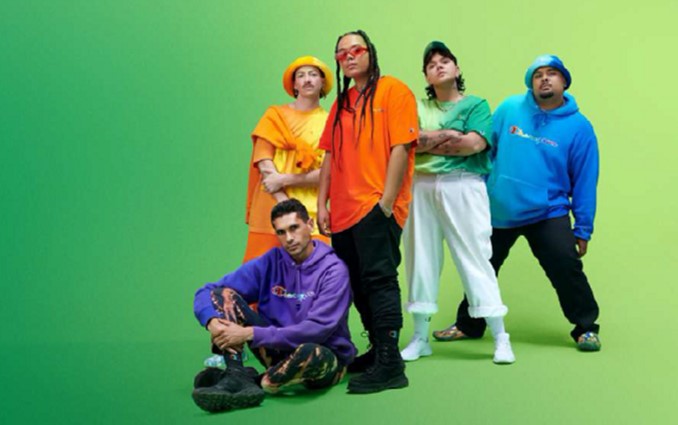
INSIDE RETAIL Heather McIlvaine June 25, 2021
MORE BRANDS ARE JUMPING ON THE PRIDE BANDWAGON. IS THAT A PROBLEM?
Australian brands and businesses are increasingly launching limited-edition Pride collections and campaigns and supporting LGBTQIA+ causes in the month of June, as the American event spreads to more countries around the world.
Earlier this month, Champion ANZ launched its first-ever Pride range, which was created in collaboration with queer artist collective Sissy Studios. The range includes tees, reverse weave hoodies, bucket hats, caps and socks in the colours of the rainbow, and it’s part of a new long-term partnership between Champion ANZ and the Queer Sporting Alliance.
Meanwhile, Queensland-based activewear brand LKSD has reimagined some of its best-selling products with rainbow colours for its first-ever Rep with Pride collection. It is donating 5 per cent of total sales from the collection to Wear it Purple, a nonprofit supporting LGBTQIA+ youth.
WHAT IS PRIDE MONTH?
The roots of Pride Month go all the way back to June 28, 1969, when hundreds of LGBTQIA+ people in New York City fought back against police persecution in what became known as the Stonewall uprising. Marches were held to commemorate the event on the same date the following year, and today, the entire month of June is recognised in the US as a time to celebrate the contributions of LGBTQIA+ people and campaign for their equality.
Over the years, LGBTQIA+ communities in other parts of the world, such as the Philippines, Brazil and many countries in Europe, have adopted June as Pride Month. But until recently, Australian LGBTQIA+ people were more likely to celebrate Sydney’s Gay and Lesbian Mardi Gras in February, or Melbourne’s Midsumma Festival in January, than Pride in June. That is starting to change.
“It’s a growing trend,” Joan Westenberg, the openly transgender woman behind Melbourne advertising and PR agency Studio Self, told Inside Retail about the growing recognition of Pride Month in Australia.
I think it relates partly to the global aspect of the queer community. So many of us are very online and we make connections across borders because we find that community wherever we can. It just kind of naturally spreads,” she said.
DEEDS, NOT WORDS
Like Halloween and Black Friday, it doesn’t necessarily matter that Pride Month lacks a history in Australia. As more people become aware of it happening overseas and more brands start to support Pride locally, it will continue to grow.
However, there’s a risk that brands that simply post rainbows on social media or launch Pride-themed products will be accused of jumping on the bandwagon or trying to profit from the LGBTQIA+ community while ignoring the very real discrimination they still face.
For instance, Westenberg only started her own agency after she struggled to get hired after she transitioned and came out as transgender.
“If a company comes out with a promotion or a branded product, people are going to ask what else are you doing? What are you doing for your employees? What are you doing for the people who work in your production lines? Where does your lobbying money go?” she said.
“There is no point in having a Pride shoe if it’s being made in factories where there aren’t provisions made for trans employees,” she said. “It’s deeds, not words. That’s what people are looking for.”
FRAMEWORK FOR CHANGE
According to Nigel Hickey, co-founder and group managing director of Jooc’d, a platform for LGBTQIA+ influencers, most brands that participate in Pride Month fall into three categories.
“The first are brands that simply rainbow wash corporate logos. The second are brands that are commercialising Pride through Pride Month limited-edition products and campaigns. The third are those that actually have a diversity statement, policy or program that is visible throughout their corporation to both shareholders and consumers, rather than just tokenism once a year,” Hickey told Inside Retail.
He pointed to the banking group ANZ, Absolut Vodka, Celebrity Cruises and Ben & Jerry’s as examples of brands that go beyond marketing campaigns to truly fight for LGBTQIA+ equality.
“If brands want to be genuinely inclusive, they should be developing a path to Pride, similarly to what they do with sustainability to ensure that all their partners from manufacturers to their marketing agencies all share the same diversity values,” he said.
“Without this organisational support and framework, we see brands and marketers making tokenistic gestures such as temporarily changing their logo for Pride Month or running short term marketing initiatives.”
VISIBILITY IS IMPORTANT
But while Hickey acknowledged that corporate participation in Pride is a problem if it’s simply about performative allyship, he also cautioned against throwing the baby out with the bathwater.
“Like any other not-for-profit organisation, the LGBTQIA+ support organisations need funding and often benefit greatly from many of these corporate initiatives and this allows them to continue the incredible work they do within the community,” he said.
“Any visibility to support change from an organisational level should still be viewed as a positive. It would be very ‘un-pride’ for organisations and brands to be calling out other brands for their level of support of the community. Whilst we want to challenge brands to go beyond tokenism and rainbow washing, we should still place value on all contributions to drive change and equality in all its shapes and colours.”
Westenberg is all for brands getting involved in Pride Month in Australia.
“I love the idea of seeing rainbows everywhere. That’s the kind of thing that I did not grow up seeing,” she said.
“If your brand is considering getting involved, I think that’s fantastic, but what I would say is ask for help and input from people in the queer community. Look for where you can do good as much as where you can do things loudly.
DISCOVER YOUR SOCIAL PURPOSE & PATH TO PRIDE WITH JOOC’D.
WANT TO KNOW MORE? CONTACT US TODAY!
More brands are jumping on the Pride bandwagon. Is that a problem?



